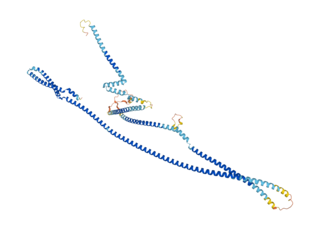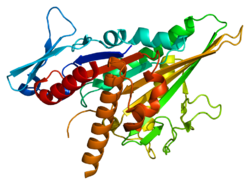
ADP-ribosylation factor-binding protein GGA3 is a protein that in humans is encoded by the GGA3 gene.

Cux1 is a homeodomain protein that in humans is encoded by the CUX1 gene.

Syntaxin-5 is a protein that in humans is encoded by the STX5 gene.

Synaptobrevin homolog YKT6 is a protein that in humans is encoded by the YKT6 gene.

Golgin subfamily A member 3 is a protein that in humans is encoded by the GOLGA3 gene.

Golgin subfamily A member 4 is a protein that in humans is encoded by the GOLGA4 gene.

Golgi SNAP receptor complex member 1 is a protein that in humans is encoded by the GOSR1 gene.

Nucleoporin 107 (Nup107) is a protein that in humans is encoded by the NUP107 gene.

ADP-ribosylation factor-like protein 1 is a protein that in humans is encoded by the ARL1 gene.

Golgi reassembly-stacking protein of 55 kDa (GRASP55) also known as golgi reassembly-stacking protein 2 (GORASP2) is a protein that in humans is encoded by the GORASP2 gene. It was identified by its homology with GRASP65 and the protein's amino acid sequence was determined by analysis of a molecular clone of its complementary DNA. The first (N-terminus) 212 amino acid residues of GRASP55 are highly homologous to those of GRASP65, but the remainder of the 454 amino acid residues are highly diverged from GRASP65. The conserved region is known as the GRASP domain, and it is conserved among GRASPs of a wide variety of eukaryotes, but not plants. The C-terminus portion of the molecule is called the SPR domain. GRASP55 is more closely related to homologues in other species, suggesting that GRASP55 is ancestral to GRASP65. GRASP55 is found associated with the medial and trans cisternae of the Golgi apparatus.

BET1-like protein is a protein that in humans is encoded by the BET1L gene.

Nuclear pore complex protein Nup133, or Nucleoporin Nup133, is a protein that in humans is encoded by the NUP133 gene.

Golgin subfamily A member 5 is a protein that in humans is encoded by the GOLGA5 gene.

GRIP and coiled-coil domain-containing protein 2 is a protein that in humans is encoded by the GCC2 gene.

Syntaxin-16 is a protein that in humans is encoded by the STX16 gene.

Nucleoporin 85 (Nup85) is a protein that in humans is encoded by the NUP85 gene.

Arfaptin-2 is a protein that in humans is encoded by the ARFIP2 gene.

GRIP and coiled-coil domain-containing protein 1 is a protein that in humans is encoded by the GCC1 gene.

Giantin or Golgin subfamily B member 1 is a protein that in humans is encoded by the GOLGB1 gene. Giantin is located at the cis-medial rims of the Golgi apparatus and is part of the Golgi matrix that is responsible for membrane trafficking in secretory pathway of proteins. This function is key for proper localisation of proteins at the plasma membrane and outside the cell which is important for cell function that is dependent on for example receptors and the extracellular matrix function. Recent animal model knockout studies of GOLGB1 in mice, rat, and zebrafish have shown that phenotypes are different between species ranging from mild to severe craniofacial defects in the rodent models to just minor size defects in zebrafish. However, in adult zebrafish a tumoral calcinosis-like phenotype was observed, and in humans such phenotype has been linked to defective glycosyltransferase function.

The Golgi matrix is a collection of proteins involved in the structure and function of the Golgi apparatus. The matrix was first isolated in 1994 as an amorphous collection of 12 proteins that remained associated together in the presence of detergent and 150 mM NaCl. Treatment with a protease enzyme removed the matrix, which confirmed the importance of proteins for the matrix structure. Modern freeze etch electron microscopy (EM) clearly shows a mesh connecting Golgi cisternae and associated vesicles. Further support for the existence of a matrix comes from EM images showing that ribosomes are excluded from regions between and near Golgi cisternae.




















